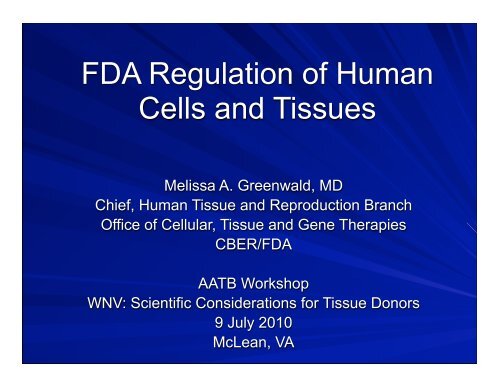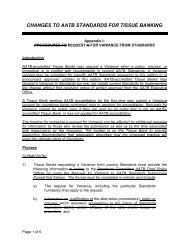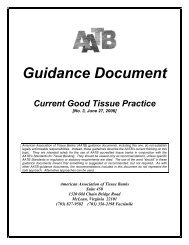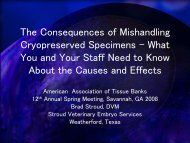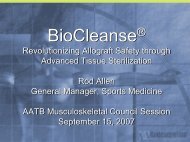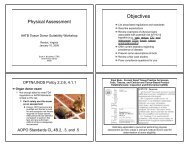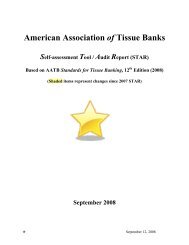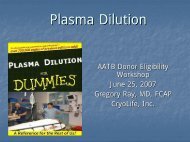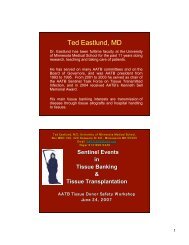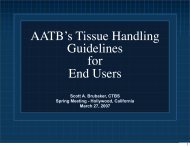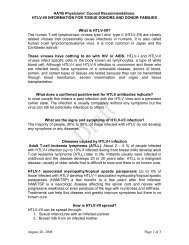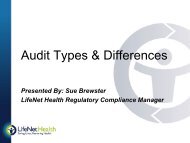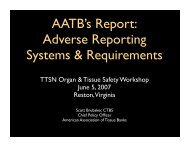FDA and Regulation of Human Cells, Tissues, and Cellular and ...
FDA and Regulation of Human Cells, Tissues, and Cellular and ...
FDA and Regulation of Human Cells, Tissues, and Cellular and ...
Create successful ePaper yourself
Turn your PDF publications into a flip-book with our unique Google optimized e-Paper software.
<strong>FDA</strong> <strong>Regulation</strong> <strong>of</strong> <strong>Human</strong><br />
<strong>Cells</strong> <strong>and</strong> <strong>Tissues</strong><br />
Melissa A. Greenwald, MD<br />
Chief, <strong>Human</strong> Tissue <strong>and</strong> Reproduction Branch<br />
Office <strong>of</strong> <strong>Cellular</strong>, Tissue <strong>and</strong> Gene Therapies<br />
CBER/<strong>FDA</strong><br />
AATB Workshop<br />
WNV: Scientific Considerations for Tissue Donors<br />
9 July 2010<br />
McLean, VA
Today’s Discussion<br />
Describe regulations related to relevant<br />
communicable disease agents or diseases<br />
(RCDADs)<br />
– Describe criteria that, according to the regulations,<br />
would be used to make decisions to include<br />
something on the list <strong>of</strong> RCDADs,<br />
Describe how infectious disease tests for HCT/P<br />
indications (living donors, specimens collected<br />
post-asystole) are licensed <strong>and</strong> approved <strong>and</strong><br />
related challenges;<br />
Describe two <strong>FDA</strong> critical path research projects<br />
related to specimens collected post-asystole<br />
2
Relevant Communicable<br />
Disease Agent or Disease<br />
(RCDAD) Considerations<br />
3
Goal <strong>of</strong> 21 CFR 1271 <strong>Regulation</strong>s<br />
HCT/Ps carry a risk <strong>of</strong> communicable disease<br />
transmission from the donor to the recipient<br />
1271 regulations are designed to minimize the<br />
risk <strong>of</strong> communicable disease transmission<br />
– Donor screening<br />
– Donor testing<br />
– Ensure cells or tissues are not contaminated during<br />
recovery, processing, storage or distribution<br />
Can only require donor screening <strong>and</strong> testing for<br />
relevant communicable disease agents or<br />
diseases (RCDADs)<br />
4
What are RCDADs<br />
RCDADS—Relevant Communicable<br />
Disease Agents or Diseases<br />
Defined by the regulations in two ways<br />
– First part <strong>of</strong> the definition lists some RCDADs<br />
by name<br />
– Second part <strong>of</strong> the definition describes criteria<br />
by which emerging or newly identified agents<br />
may be added to the “list” <strong>of</strong> RCDADs<br />
5
Adding a “new” RCDAD<br />
A communicable disease agent or disease<br />
meeting the following criteria (Sec. 1271.3(r)<br />
(2)), but not specifically listed, is relevant if it is<br />
one:<br />
1. For which there may be a risk <strong>of</strong> transmission<br />
by an HCT/P, either<br />
– to the recipient <strong>of</strong> the HCT/P; or<br />
– to those people who may h<strong>and</strong>le or otherwise come<br />
in contact with the HCT/P, such as medical<br />
personnel,<br />
because the disease agent or disease is<br />
potentially transmissible by an HCT/P;<br />
6
Adding a “new” RCDAD<br />
– <strong>and</strong> either<br />
(1) has sufficient incidence <strong>and</strong>/or prevalence to<br />
affect the potential donor population (Sec. 1271.3(r)<br />
(2)(i)(B)(1)), or<br />
(2) may have been released accidentally or<br />
intentionally in a manner that could place potential<br />
donors at risk <strong>of</strong> infection (Sec. 1271.3(r)(2)(i)(B)<br />
(2));<br />
7
Adding a “new” RCDAD<br />
2. That could be<br />
– fatal or life-threatening,<br />
– could result in permanent impairment <strong>of</strong> a body<br />
function or permanent damage to body structure, or<br />
– could necessitate medical or surgical intervention to<br />
preclude permanent impairment <strong>of</strong> body function or<br />
permanent damage to a body structure (Sec. 1271.3<br />
(r)(2)(ii));<br />
8
Adding a “new” RCDAD<br />
3. <strong>and</strong> for which<br />
– appropriate screening measures have<br />
been developed, <strong>and</strong>/or<br />
– an appropriate screening test for donor<br />
specimens has been licensed, approved, or<br />
cleared for such use by <strong>FDA</strong> <strong>and</strong> is<br />
available (Sec. 1271.3(r)(2)(iii)).<br />
9
Adding a “new” RCDAD —<br />
How does it happen<br />
According to the definition, <strong>FDA</strong> considers<br />
– risk <strong>of</strong> transmission<br />
Incidence/prevalence in donor population<br />
Transmissibility<br />
– severity <strong>of</strong> effect<br />
– availability <strong>of</strong> screening <strong>and</strong>/or testing measures<br />
The Agency relies on existing data which are<br />
<strong>of</strong>ten incomplete or imperfect<br />
10
Test Review<br />
mirror.co.uk<br />
11
Specimens Collected Post-<br />
Asystole<br />
<strong>FDA</strong> considers post-asystole (“cadaveric”)<br />
specimens to be different than blood donor<br />
specimens—e.g., may contain interfering<br />
substances; additional validation studies must<br />
be performed by the test kit manufacturer to<br />
get this claim<br />
Claims for testing specimens collected postasystole<br />
have been obtained as an additional<br />
claim (or supplement to already licensed test)<br />
for tests with an indication for use in screening<br />
blood donors<br />
<strong>FDA</strong> works with industry to encourage<br />
development <strong>of</strong> tests for use with blood<br />
specimens obtained post-asystole<br />
12
Specimens Collected Post-<br />
Asystole<br />
Guidance published November 2004<br />
“Recommendations for Obtaining a Labeling<br />
Claim for Communicable Disease Donor<br />
Screening Tests Using Cadaveric Blood<br />
Specimens from Donors <strong>of</strong> <strong>Human</strong> <strong>Cells</strong>,<br />
<strong>Tissues</strong>, <strong>and</strong> <strong>Cellular</strong> <strong>and</strong> Tissue-Based<br />
Products (HCT/Ps)”<br />
Least Burdensome Approach<br />
Predicated on blood donor screening claim;<br />
largely focused on excluding significant<br />
differences in assay performance introduced by<br />
the specimen type<br />
13
Minimal study requirements for<br />
post-asystole specimen claim<br />
Studies – sensitivity, specificity, reproducibility<br />
May do studies utilizing matched pairs <strong>of</strong> pre- <strong>and</strong><br />
post-asystole specimens OR using unmatched<br />
specimens (specimens obtained from living<br />
donors + non-living donors, but the specimen<br />
sets are not from the same individuals)<br />
– sensitivity performed using spiking study--spike<br />
analyte into both the pre-asystole <strong>and</strong> postasystole<br />
specimens (at a potency near the<br />
assay’s cut<strong>of</strong>f)<br />
Minimum <strong>of</strong> 50 specimens for sens/spec; 20<br />
specimens for reproducibility<br />
14
Minimal study requirements for<br />
post-asystole specimen claim<br />
Minimum <strong>of</strong> 3 test kit lots for each study<br />
Plasma dilution must be taken into consideration<br />
Additional information about donors <strong>of</strong> the<br />
cadaveric specimens:<br />
– Time between death <strong>and</strong> specimen collection; how/<br />
where specimen was collected<br />
– Include some hemolyzed specimens, note degree <strong>of</strong><br />
hemolysis<br />
– Note information about storage <strong>and</strong> h<strong>and</strong>ling<br />
conditions <strong>of</strong> the specimens<br />
15
Performance validation<br />
Laboratory testing--Non-clinical data to demonstrate that<br />
the manufactured product meets prescribed requirements<br />
for safety, purity, <strong>and</strong> potency<br />
– Assay precision <strong>and</strong> laboratory pr<strong>of</strong>iciency<br />
– Analytical sensitivity <strong>and</strong> specificity<br />
– Chemistry, Manufacturing <strong>and</strong> Controls<br />
Clinical evaluation--Clinical data that demonstrate safety<br />
<strong>and</strong> effectiveness for the specific intended use<br />
– Clinical sensitivity <strong>and</strong> specificity<br />
– Reproducibility<br />
– Stability<br />
16
Assay Specificity<br />
Analytical Specificity – measures a test’s<br />
ability to exclusively identify a target substance<br />
rather than different substances<br />
interfering substances<br />
other viral infections<br />
disease conditions<br />
compare signal strength between pre-asystole <strong>and</strong> postasystole<br />
specimens<br />
Clinical Specificity – measure <strong>of</strong> how <strong>of</strong>ten the<br />
test is negative in non-diseased donors<br />
specimens from low risk populations<br />
compare frequency <strong>of</strong> false-positive results between preasystole<br />
<strong>and</strong> post-asystole specimens<br />
17
Assay Sensitivity<br />
Analytical Sensitivity – measures a test’s<br />
ability to detect a low concentration <strong>of</strong> a given<br />
substance<br />
dilutional panels<br />
reference preparations to determine endpoint or LOD/LOQ<br />
low titer <strong>and</strong> seroconversion panels<br />
compare positive signal strength between pre-asystole <strong>and</strong><br />
post-asystole specimens<br />
Clinical Sensitivity – measure <strong>of</strong> how <strong>of</strong>ten the<br />
test is positive in diseased donors<br />
specimens from seroconverting individuals<br />
known positive <strong>and</strong> high risk individuals<br />
compare frequency <strong>of</strong> false negative test results between<br />
pre-asystole <strong>and</strong> post-asystole specimens<br />
18
Assay Precision <strong>and</strong> Reproducibility<br />
Assay precision – the closeness <strong>of</strong> agreement<br />
between a series <strong>of</strong> measurements obtained<br />
from multiple sampling <strong>of</strong> the homogenous<br />
sample under the prescribed conditions<br />
– Multiple operators, lots <strong>and</strong> days<br />
Reproducibility – a measure <strong>of</strong> precision<br />
between different laboratories<br />
– Multiple operators, lots, days, at different sites<br />
19
Analytical Sensitivity<br />
Example: WNV<br />
Reactivity <strong>of</strong> assay in samples containing analyte<br />
<strong>of</strong> interest, e.g., WNV RNA:<br />
– Test serial dilutions <strong>of</strong> samples containing WNV RNA<br />
– Test serial samples from individuals with WNV; if<br />
possible, samples collected frequently very early in<br />
infection (seroconversion panel)<br />
– Estimate the Limit <strong>of</strong> Detection<br />
20
Clinical Sensitivity<br />
Example: WNV<br />
Reactivity <strong>of</strong> assay in individuals with WNV<br />
infection:<br />
– test samples from persons with clinical WNV infection<br />
– test samples in epidemic WNV regions<br />
[Would also evaluate test performance in blood<br />
donor population]<br />
21
Limitations <strong>of</strong> Knowledge in Post-<br />
Asystole Specimen Testing<br />
Specificity<br />
– Data collected is relevant to “real-life” use <strong>of</strong><br />
the test<br />
– Small numbers = large confidence intervals<br />
Sensitivity<br />
– Spiking studies are used to evaluate clinical<br />
sensitivity<br />
– Small numbers = large confidence intervals<br />
22
Other Limitations<br />
Fewer options sometimes available for<br />
post-asystole specimens<br />
– Specimen tubes<br />
– Shipping<br />
– Storage<br />
Balance<br />
– Availability <strong>of</strong> information<br />
– Volume <strong>of</strong> information<br />
23
Testing Research<br />
http://www.fda.gov/ScienceResearch/SpecialTopics/CriticalPathInitiative/default.htm<br />
24
Post-Asystole Clinical Sensitivity<br />
Post-asystole specimens obtained from<br />
individuals with known HIV, HCV, HBV positive<br />
status plus controls<br />
Will test at least 25 specimens from individuals<br />
known to have been positive for each <strong>of</strong> HIV,<br />
HCV <strong>and</strong> HBV (some may have co-infections)<br />
<strong>and</strong> 25 negative controls<br />
Unlabeled specimens tested across multiple<br />
assays<br />
– Antibody<br />
– NAT<br />
– Licensed tests<br />
25
Post-Asystole Clinical Sensitivity<br />
Improve underst<strong>and</strong>ing <strong>of</strong> clinical performance <strong>of</strong><br />
tests on post-asystole specimens collected from<br />
infected individuals<br />
Overview <strong>of</strong> test performance across various<br />
tests<br />
Limitations<br />
– Prevalent disease<br />
– Small numbers<br />
– Hypothesis generating<br />
26
Post-Asystole Clinical Specificity<br />
Concern about rate <strong>of</strong> false positive test<br />
results (assay specificity performance)<br />
Clinical performance: Follow-up testing to<br />
verify “truth” <strong>of</strong> a positive test result in a<br />
deceased individual is not possible, so<br />
difficult to discern false positive from true<br />
positive<br />
Wide confidence intervals in licensed tests<br />
27
Post-Asystole Clinical Specificity<br />
Obtaining specimens from the same<br />
individual both pre- <strong>and</strong> post-asystole<br />
Specimens will be tested across multiple<br />
tests (Ab, NAT) for multiple viruses<br />
– WNV<br />
– HIV<br />
– HCV<br />
– HBV<br />
28
Post-Asystole Clinical Specificity<br />
Advantageous to directly compare results<br />
<strong>of</strong> specimens from the same individual<br />
both pre- <strong>and</strong> post-asystole (more likely to<br />
know “truth” <strong>of</strong> post-asystole specimen<br />
result)<br />
Sample size analysis performed to<br />
determine optimal number <strong>of</strong> specimens to<br />
improve precision <strong>of</strong> the specificity<br />
estimates (narrow confidence intervals)<br />
29
Other Research Topics<br />
EID Workshop (11-12 May 2010)<br />
Tissue industry-led research initiatives<br />
Tissue Safety Lab<br />
Ideas<br />
30
Closing Thoughts<br />
Many opportunities for increased data<br />
collection <strong>and</strong> review to inform donor<br />
screening <strong>and</strong> testing policy<br />
Interested in opportunities to better inform<br />
regulatory review<br />
Review policy decisions in light <strong>of</strong> new/<br />
better data, once collected<br />
31
Questions<br />
32
CBER Contact Information<br />
Website:<br />
http://www.fda.gov/BiologicsBloodVaccines/default.htm<br />
Email CBER:<br />
– Manufacturers: matt@fda.hhs.gov<br />
– Consumers, health care pr<strong>of</strong>essionals<br />
ocod@fda.hhs.gov<br />
Phone:<br />
301-827-1800 800-835-4709<br />
33


